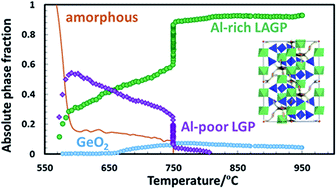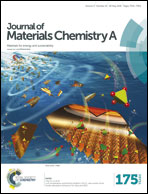Structural evolution of NASICON-type Li1+xAlxGe2−x(PO4)3 using in situ synchrotron X-ray powder diffraction
Abstract
Fast Li-ion conducting Li1+xAlxGe2−x(PO4)3 or LAGP ceramics are the most commonly used anode-protecting membranes in new generation Li–air batteries. The electrochemical properties of this solid membrane (electrolyte) are highly dependent on the purity of the phase and the actual amount of Al incorporated into the structure which often deviates from the synthetic inputs for different annealing conditions. Hence, optimizing the annealing temperature range is of great importance to achieve desirable phases and therefore optimized properties. Here in situ synchrotron X-ray diffraction is carried out during the synthesis of LAGP. Starting with ball-milled and calcined LAGP glass powders we observe the structural evolution during the glass to ceramic transition. Sequential Rietveld refinements show that the dominant Al-poor LGP phase transforms into an Al-incorporated LAGP structure at temperatures higher than 800 °C. The c lattice parameter is found to be highly dependent on the temperature and also the amount of Al incorporated into the structure. The relationship between the c lattice parameter and Al concentration in LAGP is evaluated and the correlation can be used to allow the estimation of Al doping. Thus this work allows the lattice parameter to “fingerprint” the dopant concentration.


 Please wait while we load your content...
Please wait while we load your content...